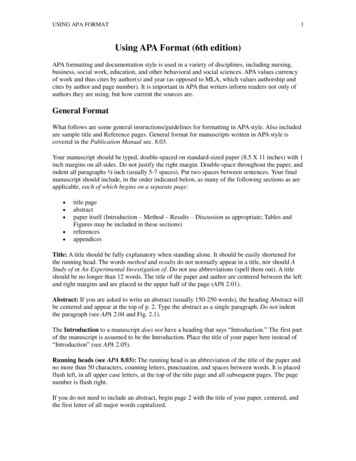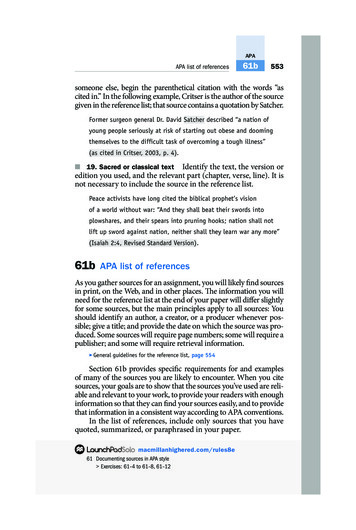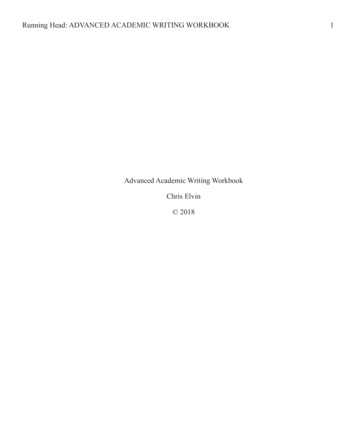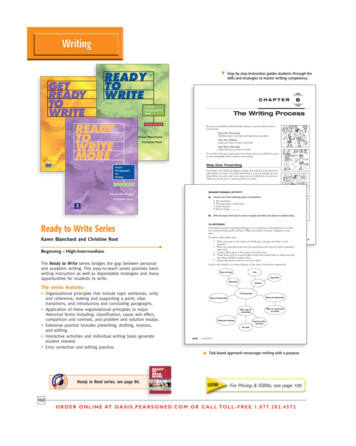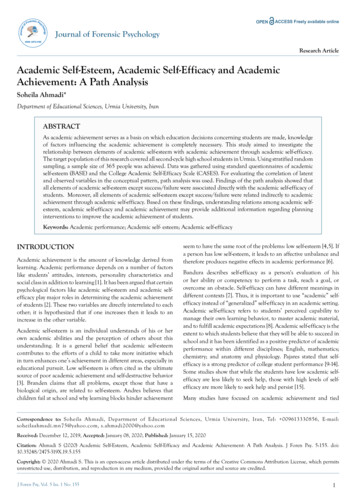
Transcription
1APA for Academic Writing (Fall 2019)What Is Referencing/Citation?Whenever you use other people’s words, ideas, information, or images in your own work, you need to identify the source accurately to1) give credit to the original creators of the work and 2) provide your reader with a reliable path to the original source.What Is Plagiarism?Plagiarism is a form of academic misconduct that occurs when a student uses the work of others but fails to accurately cite it.Inaccurate citations make it difficult or impossible for your reader to locate the original source. Missing citations give the impressionthat you are trying to take credit for the work of others. Plagiarism commonly results in a 0% on the assignment; however, dependingon the circumstances, the consequence could escalate to the student being required to leave MRU temporarily or permanently. Tolearn more about avoiding plagiarism, see the resources at www.mtroyal.ca/codeofstudentconduct.What Is APA?APA style was created by the American Psychological Association (APA). There are many different style guides (e.g., MLA,Chicago, SAA, Harvard), and each one is basically a set of rules for referencing and formatting documents. The Publication Manualof the American Psychological Association (6th ed.) is the main source of information for this handout, but we have also used the APAStyle Guide for Electronic References (6th ed.) and the APA Style Blog (https://blog.apastyle.org/).What Does APA Referencing Look Like?There are two parts:1.In-text citations (within the body of your paper): Each in-text citation gives just enough information on a particular source to“point” the reader to the corresponding, more detailed entry on the reference list.Educators and parents are becoming increasingly concerned about the addictive properties of socialmedia. A recent study of secondary school students in the UK found that Instagram addiction was linked todeclining mental health (Taprobane & Boucher, 2018, p. 139). Previous studies found a connection betweencompulsive Facebook and Twitter use and anxiety (Kahale, 2016; Park, 2019). In addition to mental healthconcerns, social media use has been . . .2.The reference list (on a separate page at the end of your paper): This is the list of sources you used and cited in your paper.ReferencesKahale, D. (2016). The Facebook dilemma. Toronto, Canada: University of Toronto Press.Park, J. (2019, May 29). Tweets, fake news, and anxiety. The New York Times. Retrieved fromhttps://www.nytimes.com/Taprobane, K., & Boucher, M. L. (2018). Secondary school students and Instagram addiction. Journal ofBehavioral Health, 9, 124-149. https://doi.org/10.1350/2006.7.2018.18firs
2In-Text CitationsWhat Are the Three Elements of an In-Text Citation?1.author’s last name[APA p. 174]2.year of publication[APA p. 185]3.page number*[APA pp. 170-172]*For quotations, a page number is required. For paraphrases, the page number is optional but recommended.How Do I Format the Three Elements?[APA pp. 92, 170-172]You have 2 choices:Format 1Format 2Put all 3 elements in parentheses at the end of theUse the author’s name and year of publication in yoursentence. Use commas to separate the elements.sentence, and place the page number in parentheses atthe end.ParaphraseOne researcher emphasized the necessity of flexibleLee (2007) emphasized that flexible thinking is vitalthinking for coping with rapidly changing technologyfor coping with rapidly changing technology (p. 82).(Lee, 2007, p. 82).Place the period after the citation!Short quotation(up to 39 words)One researcher stated that “the ability to think criticallyLee (2007) stated, “The ability to think critically isis needed in this revolutionary age of technologicalneeded in this revolutionary age of technologicalchange” (Lee, 2007, p. 82).change” (p. 82).NOTE: A quotation should not stand alone as its own sentence. You must incorporate quotations into your sentences (as in theexamples above). In many disciplines, paraphrasing is preferable to quoting; check with your instructors for guidance on this.What If the Source Has More Than One Author?2 authorsFormat 1Format 2----- (Smith & Jones, 2004, p. 93).Smith and Jones (2004) found that ----- (p. 93).use & between names3-5 authors[APA p. 177]use “and” between namesThe first time you cite the source in your paper:The first time you cite the source in your paper:----- (Simpson, Stahl, & Francis, 2004, p. 9).Simpson, Stahl, and Francis (2004) argued that ----- (p. 9).notice the commanotice the commaEvery other time you cite that same source:Every other time you cite that same source:----- (Simpson et al., 2004, p. 18).Simpson et al. (2004) argued that ----- (p. 18).notice the period and comma6 authors----- (Kallai et al., 2011, p. 121).Kallai et al. (2011) noted that ----- (p. 121).
3[APA pp. 171-172, 176-177]What If One of the Three Elements Is Missing?Missing ElementWhat to DoFormat 1Format 2No page numbers,and the source hasNO headingsIdentify the paragraphwhere the informationappears----- (Enmax, 2017, para. 7).According to figures reported byEnmax (2017), ----- (para. 7).No page numbers,and the source hasheadingsUse the heading, andidentify the paragraphbelow the heading wherethe information appears----- (Lachs, 2019, Proposed Solution,para. 2).Lachs (2019) suggested that ----(Proposed Solution, para. 2).notice the capital lettersNOTE: Long headings should be shortened to a fewwords. If you shorten a heading, use quotationmarks around it.No author’s nameNo dateUse the title of the sourceUse n.d.----- (Lachs, 2019, “Ways,” para. 2).Lachs (2019) suggested that ---(“Ways,” para. 2).----- (“Plastic Bags,” 2019, para. 3).The article “Plastic Bags in GreenBins OK in Ottawa as of Today”(2019) noted that ----- (para. 5).NOTE: Use only the first few words of the titlewhen following Format 1.NOTE: Use quotation marks and capital lettersfor all major words.----- (Liu, n.d., para. 3)Liu (n.d.) emphasized ----- (para. 3).What If the Author Is an Organization, Not a Person?[APA pp. 176-177]Format 1Format 2Organization withouta commonly used abbreviation----- (Calgary Meals on Wheels, n.d., para. 3).Calgary Meals on Wheels (n.d.) provides -----Organization WITHa commonly used abbreviationThe first time you cite the source in your paper:The first time you cite the source in your paper:----- (World Health Organization [WHO], 2018,World Health Organization (WHO, 2018)para. 4).warned that ----- (para. 4).Every other time you cite that same source:Every other time you cite that same source:----- (WHO, 2018, para. 4).WHO (2018) warned that ----- (para. 4).(para. 3).How Do I Cite a Source Found in Another Source?[APA p. 178]Often an author cites someone else’s work. Wherever possible, it is best to track down the original source of the idea. If this is notpossible, follow the format below, where Kamura is the source you read, and Patel is the original source. (Remember that the author ofthe source you read goes after the words “as cited in”). Include only Kamura’s article in your reference list.Format 1Format 2Little empirical research on students’ critical thinking existsA 2016 review by Patel found little empirical research on(Patel, as cited in Kamura, 2018, p. 83).students’ critical thinking (as cited in Kamura, 2018, p. 83).the source you readthe source you read
4[APA p. 179]What Is Personal Communication?When you use a source that is not retrievable by your reader (e.g., face-to-face conversation, guest speaker in class, notes you tookduring class, an email), cite the information as personal communication. Do not include the source on your reference list.Format 1Format 2----- (P. Rand, personal communication, May 22, 2019).P. Rand (personal communication, May 22, 2019) observed that ---- .How Do I Cite a Long Quotation (40 or more words)?[APA pp. 92, 170-172] Introduce the quotation with a complete sentence and a colon. Use a block format (indenting all lines approximately half an inch), and do not use quotation marks. Long quotations should be used sparingly.Wang, Johnston, Juarez, and Marks (2010) described effective time management as an ongoing process:Time management takes self-awareness, planning, execution, and reflection. The perception of time management is that theonce a schedule is created, the work is done, but that is only the first step. Successful students are adaptable and able to makechanges to a schedule because they can purposefully and proactively move tasks around to adjust to new situations. (p. 27)For long quotations, the period goes before the parentheses!If I Use the Same Source More Than Once in a Paragraph, Do I Have to Cite It Each Time?[APA pp. 174-175]Yes! Citation must be dealt with sentence by sentence. Within a single paragraph, when several sentences all contain information fromthe same source, don’t make the mistake of citing only the first or last sentence. You know which ideas came from the source, but theonly way your reader can know is through citations. There is one shortcut, but it only applies if you are using Format 2 (see p. 2).After the first citation, you can omit the year in subsequent sentences as long as it is clear you are referring to the same source (e.g., byrepeating the author name or using cues like “the researchers” or “their study”). Remember that this only works within a paragraph.When students begin to incorporate the use of specific strategies, self-monitoring, and self-reflection into their academicendeavours, they are more successful in reaching their goals. In their examination of students’ acquisition of learning strategies,Simpson, Stahl, and Francis (2004) stressed that students will use a strategy if they understand how, why, and when to use it (p. 3).The researchers argued that students typically need multiple exposures to a new strategy before they decide to adopt it for themselves(p. 3). They also proposed that using the specific strategy taught in a course is often less important than using the metacognitiveprocesses of “selecting, summarizing, organizing, elaborating, monitoring, self-testing, reflecting and evaluating” when working oncourse content (p. 4). Students need to carefully analyze their assignments in order to select the most appropriate processes to engagein (Simpson et al., 2004, p. 4).If you switch to Format 1, use a complete citation.Are In-Text Citations Always Placed at the End of a Sentence?No. Sometimes an in-text citation needs to be placed earlier in a sentence. In the following example, the student has paraphrasedsource information in the first part of the sentence but has continued the sentence with their own analysis:Although persistence was identified as the most influential factor (Twoyoungmen, 2010, p. 96), the study lacked sufficient detail.information from the sourcestudent’s own idea
5Creating Your Reference ListThe basic pattern for a reference list entry isAuthorYear of publicationTitle of work*Publication data*Tip: For titles of works, capitalize only the first word, the word after a colon or a dash, and proper nouns. Follow this APA rule evenif the original source you consulted shows the title with capital letters on all major words.Here are examples of four common types of sources:Book(with editionstated)Journalarticle author year published book edition publisherMcWhorter, K. (2010). Academic reading (7th ed.). Boston, MA: Longman. book title author year published place published article title journal name volumePerrey, S. (2017). Do we perform better when we increase red blood cells? The Lancet Haematology, 17, 2352-3026. page rangehttps://doi.org/10.1016/S2352-3026(17)30123-0 DOIChapter in anedited book chapter authors year published chapter title book editors book titleSmith, F. M., & Jones, W. (2004). The college student. In C. Wood & M. Meyer (Eds.), Cross-cultural education(pp. 75-105). London, Canada: MacMillan. chapter page rangeWebpage onwebsite author year published place published publisher webpage title date you viewed the webpageSah, P. (2018). Study habits for success: Tips for students. Retrieved August 23, 2019, ccess-tips-for-students-89147 URL for the webpageHow to Create a Reference List Entry1.Look at your source, and ask yourself, “What type of source is it?”Is it a book? An article? A webpage? A report? For online sources, this can be a tricky question to answer. If you are unsure,get help at the Library Service Desk or Student Learning Services.2.Find the corresponding section in the Reference Examples pages of this guide (pp. 7-12).For example, if your source is a journal article, go to section C on page 8.3.Find the example that most closely fits your source. You might need to combine two examples to get the best fit.For example, if your journal article has a DOI but has two authors, you will need to combine C2 and C3.4.Follow the following formatting details in each example closely (e.g., italics, punctuation, capitalization).On the following page, you will see a sample reference list. Notice the important rules in the left-hand column!
6RULESReferencesStart yourreference liston a new pageAlberta Social Services and Community Health. (2005). Breaking the pattern: Understanding wife abuse. Edmonton,[APA p. 37]Ancient tool makers discovered fire treatment. (2009, August 13). The Globe and Mail. Retrieved fromCanada: Author.https://www.theglobeandmail.com/Include onlysources cited inyour paper*Arnold, A. (1985). Afghanistan: The Soviet invasion in perspective (Rev. ed.). Retrieved from[APA pp. 177-180]Bohren, M. A., Hofmeyr, G. J., Sakala, C., Fukuzawa, R. K., & Cuthbert, A. (2017). Continuous support for womenhttp://books.google.com/during childbirth. Cochrane Database of Systematic Reviews, 2017(7). https://doi.org/10.1002/14651858Put entries inalphabeticalorder,according tothe first letterof the entry[APA pp. 181-183].CD003766.pub6Brandt, F. (Producer), & Messina, P. F. (Director). (1995). Too smart for strangers [Motion picture]. Burbank, CA:Walt Disney Home Video.Canadian Nurses Association. (2017). Code of ethics for registered nurses. Retrieved from 7-Edition/files/assets/basic-html/page-1.htmlCell division. (2008). In E. Martin & R. Hine (Eds.), Dictionary of biology. Retrieved fromURL with ahyperlink orwithout; justbe consistent[APA Style Blog,April 21, 2015]Start each new entryat the leftmargin[APA p. 180]http://www.oxfordreference.comDowning, L., Carter, J. C., & McManus, T. (2007). Students in our midst. Toronto, Canada: Doubleday.Family Counselling Centre. (2003). Dealing with a delinquent student [Brochure]. Calgary, Canada: Author.Fung, M. (2006, December 12). Asthma rates increasing. Winnipeg Free Press, pp. C4, C7 C8.Kallai, J., Makany, T., Csatho, A., Karadi, K., Horvath, D., Kovacs-Labadi, B., . . . Jacobs, J. W. (2007). Cognitive andaffective aspects of thigmotaxis strategy in humans. Behavioral Neuroscience, 121, 21 , N. (2002). The new apartheid [Review of the book We are the poor: Community struggles in post-apartheidSouth Africa, by A. Desai]. Nation, 275, 25 28.Kushner, K. E., & Jackson, M. (2019). Health and wellness. In B. J. Astle et al. (Eds.), Canadian fundamentals ofUse a ½-inch hangingindent forsubsequentlines of anentry(Tip for PCusers: Ctrl t)nursing (6th ed., pp. 1–17). Milton, Canada: Elsevier Canada.O’Brien-Pallas, L., Hiroz, J., Cook, A., & Mildon, B. (2005). Nurse-physician relationships: Solutions andrecommendations for change. Retrieved from http://deslibris.caSah, P. (2018). Study habits for success: Tips for students. Retrieved August 23, 2018, uccess-tips-for-students-89147Simpson, M. L., Stahl, N. A., & Francis, M. A. (2004). Reading and learning strategies: Recommendations for the 21 stcentury. Journal of Developmental Education, 28(2), 2 15, 32.Use publishername only:MacMillanPublishers Ltd.Smith, F. M., & Jones, W. (2004). The college student. In C. Wood & M. Meyer (Eds.), Cross-cultural education (pp.75–105). London, Canada: MacMillan.Touhy, T. A., & Jett, K. (2018). Ebersole and Hess’ gerontological nursing and healthy aging (5th ed.). St. Louis, MI:Elsevier.[APA p.187]*Remember that sources for personal communication do not go on the reference list. Other sources that do not go on the reference listare religious works (e.g., the Bible, the Qur’an) and major classical works (e.g., Homer’s The Odyssey).[APA pp. 174, 178-180]
7Reference ExamplesA. BooksREMEMBER: For book titles, capitalize only the first word, the first word after a colon, and proper nouns.A1 Book, 1 author, no edition[APA p. 202]A2 Book, 2 authors, editionstated[APA pp. 203, 205]A3 Book with 3 to 7 authors,not from U.S.[APA p. 184]Johnston, M. (2009). Perspective, persistence, and learning. Thousand Oaks, CA: Sage.NOTE: For U.S. publications, use the city followed by the two-letter abbreviation for the state.Touhy, T. A., & Jett, K. (2018). Ebersole and Hess’ gerontological nursing and healthy aging (5thed.). St. Louis, MI: Elsevier.Downing, L., Carter, J. C., & McManus, T. (2007). Students in our midst. Toronto, Canada:Doubleday.NOTE: For non-U.S. publications, use the city followed by the country.A4 E-book of print bookretrieved from librarysubscription database[APA p. 203; Electronic Guide p. 17]A5 Translation: Englishtranslation of a non-EnglishbookO’Brien-Pallas, L., Hiroz, J., Cook, A., & Mildon, B. (2005). Nurse-physician relationships: Solutionsand recommendations for change. Retrieved from http://deslibris.caNOTE: APA accepts the URL with or without a hyperlink. Check with each professor what you should do.Mancusa, S., & Viola, A. (2015). Brilliant green: The surprising history and science of plantintelligence (J. Benham, Trans.). Washington, DC: Island Press.[APA pp. 178-179, 199, 204-205]B. Entries and Chapters in Edited Books (includes encyclopedia and dictionary entries)NOTE: These entries should begin with the author(s) of the chapter/story/poem, but remember to give credit to the editor(s) as well.B1 Chapter with known authorin an edited book[APA p. 204]B2 Chapter with known authorin an edited book with alarge editorial board[APA pp. 182, 184, 204]B3 Chapter with known authorfrom an edited book,included in a course pack[APA p. 204]Smith, F. M., & Jones, W. (2004). The college student. In C. Wood & M. Meyer (Eds.), Cross-culturaleducation (pp. 75-105). London, Canada: MacMillan.Kushner, K. E., & Jackson, M. (2019). Health and wellness. In B. J. Astle et al. (Eds.), Canadianfundamentals of nursing (6th ed., pp. 1-17). Milton, Canada: Elsevier Canada.NOTE: Normally all editors would be listed. As this book has a large editorial board, we only included the firsteditor listed on the title page (B. J. Astle) followed by et al. If the chapter has both an original and a Canadianauthor listed, include both in your reference.Jefferson, T. (2008). Masculinities and crimes. In D. E. King, & J. A. Winterdyk (Eds.), Diversityissues and the criminal justice system: Course readings for Applied Justice Studies (AJUS)2231 (pp. 325-347). Calgary, Canada: Mount Royal University. (Reprinted from The Oxfordhandbook of criminology (2nd ed.), pp. 535-557, by M. Maguire, R. Morgan, & R. Reiner,Eds., 1997, Oxford, England: Oxford University Press).NOTE: In-text citations should include the original publication date as well as the course pack publication date,e.g., (Jefferson, 1997/2008, p. 326). Use the course pack page numbering if available. If the course pack does nothave its own page numbers, use the original page numbers of the chapter.B4 Entry/definition in printencyclopedia, authorknown [APA p. 202]Davidson, T. (2002). Common cold. In J. L. Longe (Ed.), The Gale encyclopedia of medicine (2nd ed.,B5 Entry/definition in a webencyclopedia, authorunknown [APA p. 202]Cell division. (2008). In E. Martin & R. Hine (Eds.), Dictionary of biology. Retrieved fromVol. 2, pp. 869-872). Detroit, MI: Gale Group.http://www.oxfordreference.com
8C. Articles: Journals and Periodicals (newspapers, magazines, newsletters)NOTE: For the name of the journal (not the article, but the journal itself), capitalize all major words.C1 Scholarly journal article,1 author, print version,no DOI availableLee, K. (2007). Online collaborative case study learning. Journal of College Reading and Learning,37(2), 82-100.[APA p. 199]C2 Scholarly journal article,1 author, from a librarydatabase, with DOI[APA p. 198; Electronic Guide p. 12; APAStyle Blog March 1, 2017]C3 Scholarly article, 2 authors,found through web search,not a library database[APA pp. 191-192, 199]Perrey, S. (2017). Do we perform better when we increase red blood cells? The Lancet Haematology,17, 2352-3026. https://doi.org/10.1016/S2352-3026(17)30123-0NOTE: A digital object identifier (DOI) should be included at the end of the reference.If there is a DOI, keep the volume number, but omit the article’s issue number.APA will accept the following formats for the Rhttp://dx.doi.org/10.1016/S2352-3026(17)30123-0 ORdoi:10.1016/S2352-3026(17)30123-0APA recommends that you pick one format to use consistently in your paper.Brown, C., & Austin, D. (2009). Commentary: Fatty acids, breastfeeding and autism spectrum disorder.E-journal of Applied Psychology, 5(1), 49-52. Retrieved fromhttps://researchbank.swinburne.edu.au/NOTE: Provide the URL of the journal home page.C4 Scholarly journal article, upto 7 authors, from a librarydatabase, no DOI[APA p. 199]C5 Scholarly journal article,more than 7 authors, withDOI: list first 6, then use. . . and list last authorSimpson, M. L., Stahl, N. A., & Francis, M. A. (2004). Reading and learning strategies:Recommendations for the 21st century. Journal of Developmental Education, 28(2), 2-15.NOTE: Italicize the journal name and volume number but not the issue number. Some articles may not have anissue number; in that case, omit it.Kallai, J., Makany, T., Csatho, A., Karadi, K., Horvath, D., Kovacs-Labadi, B., . . . Jacobs, J. W.(2007). Cognitive and affective aspects of thigmotaxis strategy in humans. BehavioralNeuroscience, 121, 21-30. https://doi.org/10.1037/0735-7044.121.1.21[APA p. 198; Electronic Guide p. 12]C6 Scholarly journal article,with article numberNorouzi, N., Bhakta, H. C., & Grover, W. H. (2017). Sorting cells by their density. PLoS ONE, 12, 116. https://doi.org/10.1371/journal.pone.0180520NOTE: Some journals provide an article number (e.g., 0180520), but you do not include it in your reference. If anarticle does not have page numbers, continue to the next part of the reference list entry.C7 Scholarly journal article, inpress, retrieved from thewebBaum, D. (in press). The origin and early evolution of life in chemical composition space. Journal ofTheoretical Biology. Retrieved from nic Guide p. 13]C8 Cochrane Database ofSystematic Reviews,from a library databaseBohren, M. A., Hofmeyr, G. J., Sakala, C., Fukuzawa, R. K., & Cuthbert, A. (2017). Continuoussupport for women during childbirth. Cochrane Database of Systematic Reviews, pub6
9C9 Newspaper article, withauthor, on the web, notfrom a library databaseHarris, M. (2011, August 16). Grades improve if classes start later, studies find. The Calgary Herald.Retrieved from https://calgaryherald.com/[APA pp. 200-201; Electronic Guide p. 9]C10 Newspaper article, authorunknown, on the web, notfrom a library databaseAncient tool makers discovered fire treatment. (2009, August 13). The Globe and Mail. Retrieved fromhttps://www.theglobeandmail.com/[APA p. 200]C11 News story on mediawebsite, author unknown(e.g., CBC, BBC, CNN)Raccoon in Banff eludes Parks Canada staff. (2017, October 28). Retrieved tional-park-raccoon-1.4377055[ APA Style Blog]C12 Magazine article withauthor, print version[APA p. 200]C13 Magazine article, withauthor, web version[APA p. 200]C14 Review of book, in amagazine, from a librarydatabase, no DOISinger, P. (2011, August). Visible man: Ethics in a world without secrets. Harper’s Magazine,323(1935), 31-36.Wells, P. (2009, July 28). Our universities can be smarter. Maclean’s, 122(29/30). Retrieved fromhttps://www.macleans.ca/Klein, N. (2002, December 16). The new apartheid [Review of the book We are the poor: Communitystruggles in post-apartheid South Africa, by A. Desai]. Nation, 275(21), 25-28.[APA p. 209]D. WebsitesD1 Webpage on website,with author[APA p. 192, 205]Sah, P. (2018). Study habits for success: Tips for students. Retrieved August 23, 2018, ccess-tips-for-students-89147NOTE: A retrieval date is required because the content of a webpage can change over time.D2 Webpage on website,group or corporateauthor, no date[APA pp. 192, 205-206]D3 Document on a website,group or corporate author[APA pp. 206]World Health Organization. (n.d.). Electromagnetic fields (EMF): Research agenda. Retrieved July 17,2018, from : For an organization with an acronym, write its name in full on the reference list, and do not include itsacronym (APA Style Blog, October 28, 2015).Canadian Nurses Association. (2017). Code of ethics for registered nurses. Retrieved OTE: A retrieval date is not required because the content of documents (e.g., PDFs) posted to a website is notlikely to change.D4 Multiple pages from a singlewebsite, same author, sameyearThe Mustard Seed. (n.d.-a). About us. Retrieved May 30, 2019, from https://theseed.ca/about-us/The Mustard Seed. (n.d.-b). Services. Retrieved May 30, 2019, from https://theseed.ca/services/[ APA Style Blog, Oct. 20, 2011]The Mustard Seed. (n.d.-c). Take action. Retrieved May 30, 2019, from https://theseed.ca/take-action/NOTE: You need a separate entry for each individual webpage on a website. Put the entries in alphabetical orderby the title of the page (e.g., “About us”), and add a, b, c to the year (e.g., 2017a). If the year is not known, theninsert a hyphen after n.d. (i.e., n.d.-a). An example of an in-text citation for the first entry above would be(The Mustard Seed, n.d.-a, “30 Years,” para. 3).
10E. Other Kinds of Information SourcesE1 Government report,publisher is same as author,print versionAlberta Social Services and Community Health. (2005). Breaking the pattern: Understanding wifeabuse. Edmonton, Canada: Author.[APA p. 205]E2 Government report on awebsite, with author[APA p. 205]Sosiak, A. (1999). Evaluation of recent trends in water quality in the Elbow River upstream fromGlenmore Reservoir. Retrieved from Alberta Environment and Sustainable ResourceDevelopment website: https://open.alberta.ca/publications/0778514714E3 Report (found on website)by organization thatis part of a larger entity(larger entity listed 1st)U.S. Department of Health and Human Services, Office on Women’s Health. (2017). Final report:Opioid use, misuse, and overdose in women. Retrieved inal-report-opioid-508.pdf[APA pp. 205 (#31)-206 (#32)]E4 Table on Statistics Canadawebsite[APA p. 211]E5 Government data set, on awebsite[APA p. 211; APA Style Blog]Statistics Canada. (2018). Canadian health characteristics, annual estimates [Table]. Retrieved ion?pid 1310009601Statistics Canada. (2017). Mother tongue (10), age (27) and sex (3) for the population of Canada,provinces and territories, census divisions and census subdivisions, 2016 census [Data set].Retrieved from ex-eng.cfmE6 Canadian legislation on awebsite[not covered in APA; refer to NOTE]E7 ERIC document withDocument ReproductionService number identifiedCriminal Code, RSC 1985, c C-46NOTE: The Canadian Guide to Uniform Legal Citation 8th Edition (2014) is available in the MRU Library.Beswick, D. M., Chuprina, L., & Canipe, J. B. (2002). Investigating self-directed learning inculture, learning styles and creativity. Retrieved from ERIC database. (ED473804).[Electronic Guide p. 31]E8 Report from Euromonitorin Passport GMID databaseEuromonitor. (2017). Consumer lifestyles in Canada. Retrieved from Passport GMID database.E9 Brochure, corporate author,publisher is same as authorFamily Counselling Centre. (2003). Dealing with a delinquent student [Brochure]. Calgary, Canada:[APA p. 186]E10 Class handouts or slides(ppt) on course Blackboardsite[APA pp. 205-206]Author.Samuels, M. (2010). Midterm review points. Retrieved from Mount Royal University PSYC1105Blackboard website: http://courseware.mymrc.ca/courses/1/PSYC-2200081 Psychology 200301/content/midterm Review Points.docNOTE: A handout/ppt posted on Blackboard may also be cited as personal communication, so check how yourinstructor wants it cited.E11 Lab manual, print versionDepartment of Biology. (2015, Fall). BIOL 1204 lab manual. Calgary, Canada: Mount Royal[APA pp. 211-212]University.E12 Lab manual, online, for asingle lab, posted on courseBlackboard site[APA pp. 204, 211-212]Department of Biology. (2017, Fall). Lab 1 – Phylogenetics. In BIOL 1204 lab manual. Retrievedfrom Mount Royal University BIOL1204 Blackboard website: tent/file?cmd view&content id 3926888 1&course 1
11E13 Nursing PracticeReference Guide[APA pp. 249, 251]E14 Image on a website,with photographer, dateand title[Electronic Guide p. 27]E15 Image on a website,no photographer, no title,no dateSchool of Nursing & Midwifery. (2018). Bachelor of Nursing reference guide. Calgary, Canada:Mount Royal University.Mylayne, J.-L. (2017). Together [Photograph]. Retrieved fromhttps://www.moma.o
APA style was created by the American Psychological Association (APA). There are many different style guides (e.g., MLA, Chicago, SAA, Harvard), and each one is basically a set of rules for referencing and formatting documents. The Publication Manual


